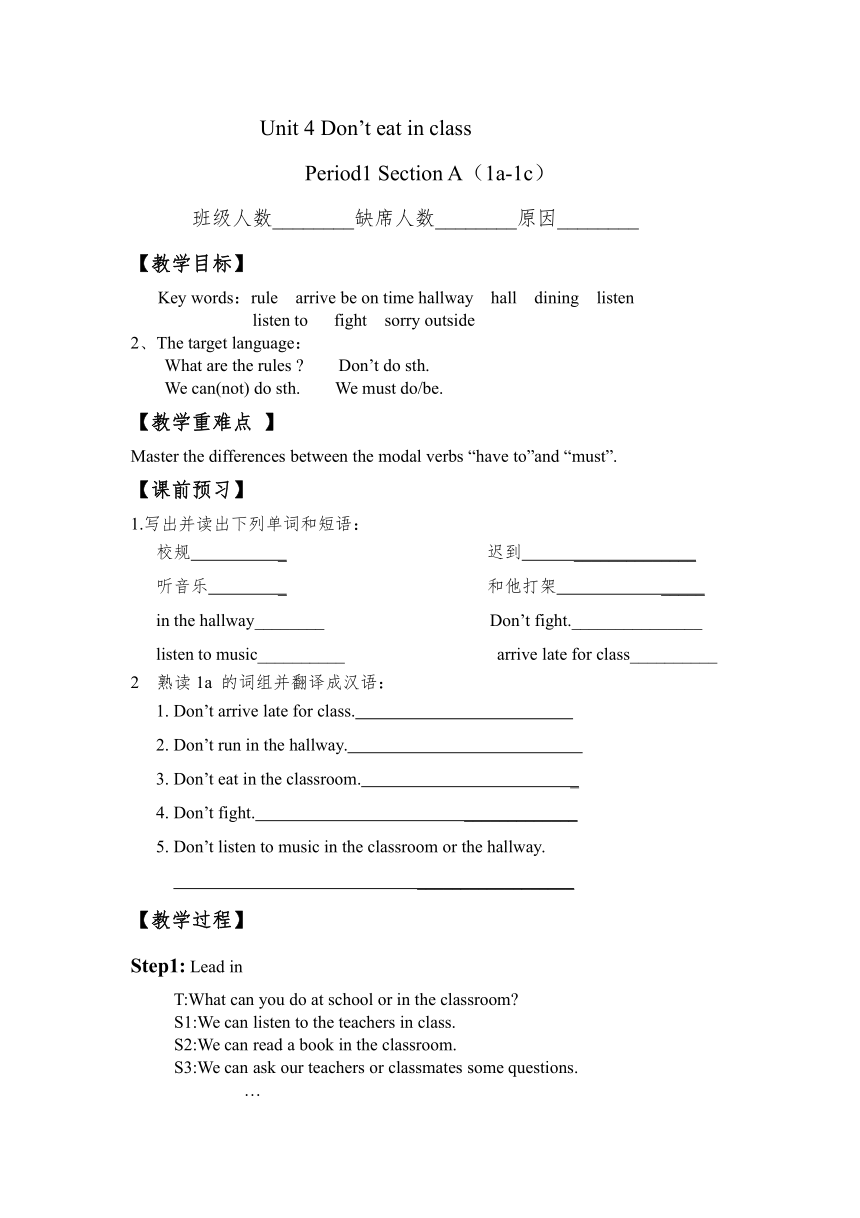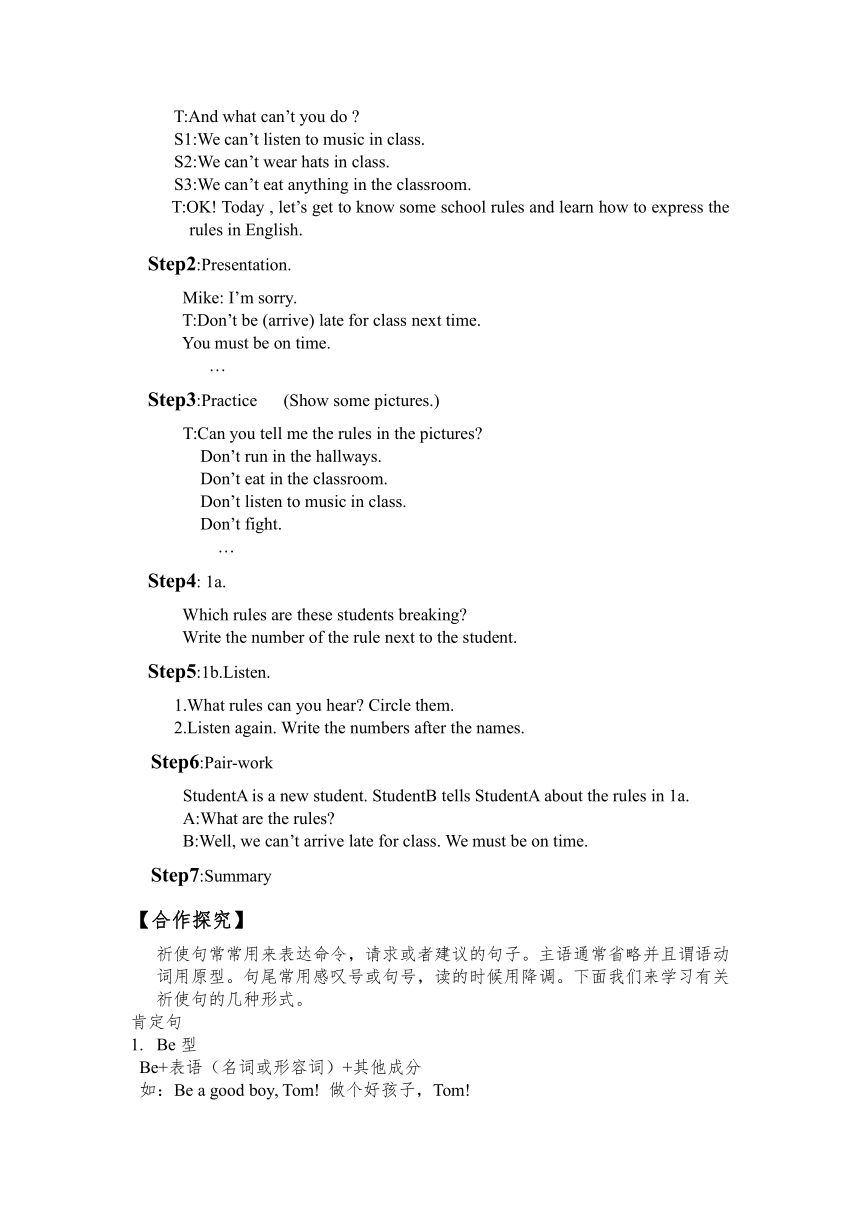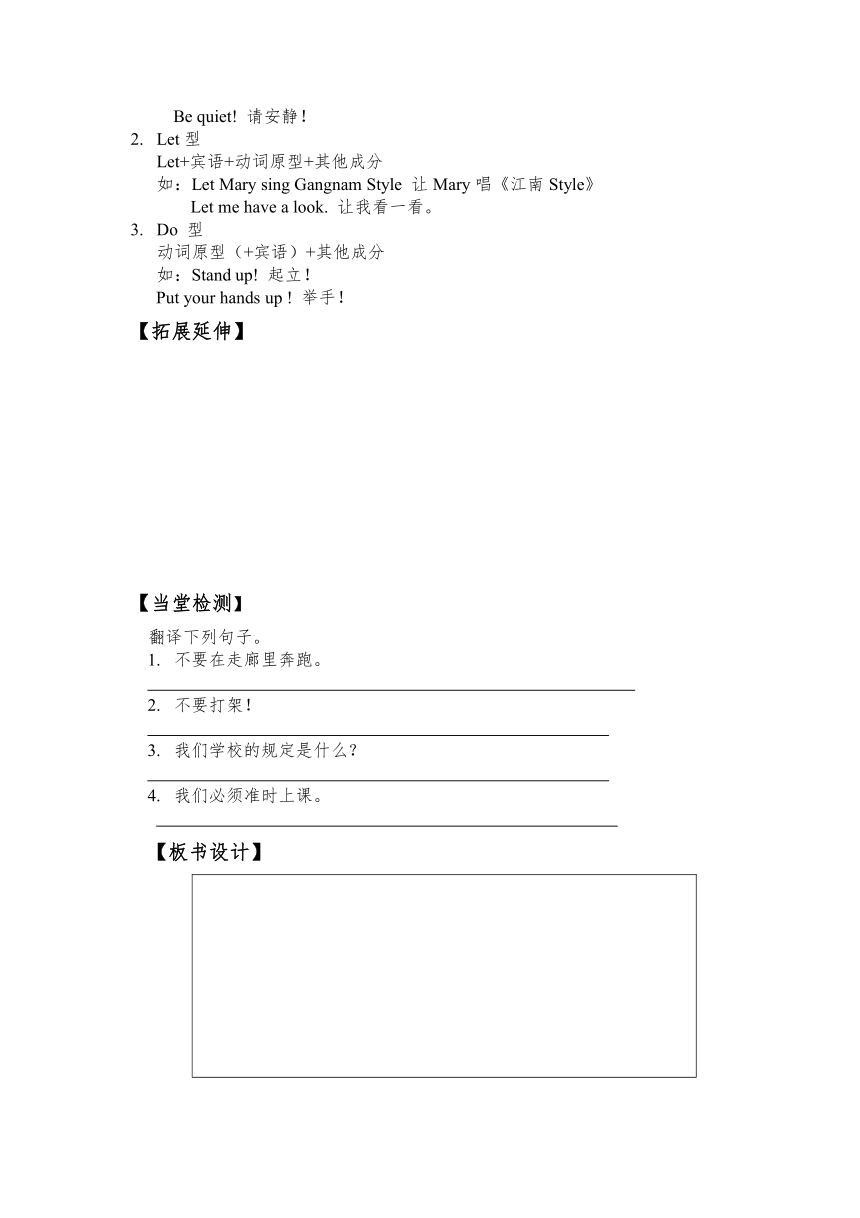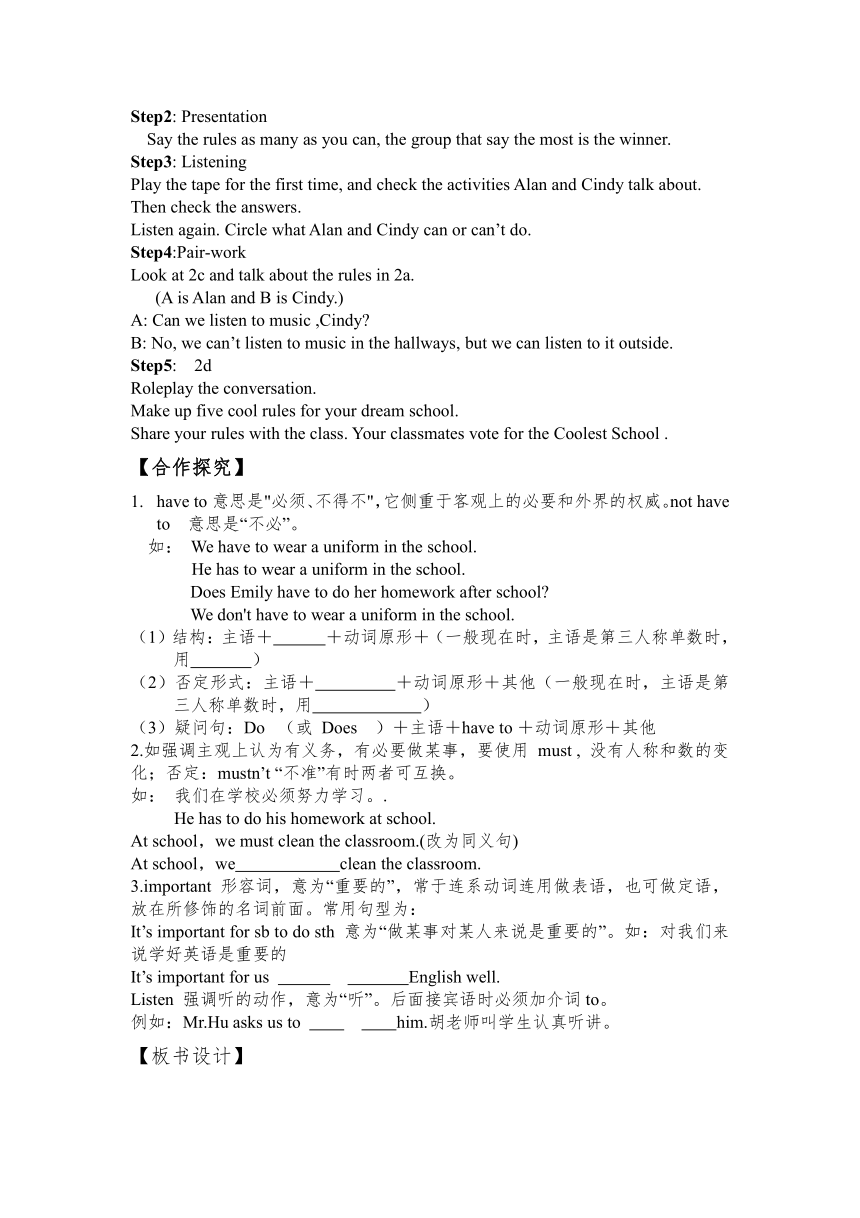Unit 4 Don’t eat in class 教案(共5课时) 2023-2024学年人教版七年级英语下册
文档属性
| 名称 | Unit 4 Don’t eat in class 教案(共5课时) 2023-2024学年人教版七年级英语下册 |  | |
| 格式 | docx | ||
| 文件大小 | 33.7KB | ||
| 资源类型 | 教案 | ||
| 版本资源 | 人教新目标(Go for it)版 | ||
| 科目 | 英语 | ||
| 更新时间 | 2024-06-16 20:33:00 | ||
图片预览





文档简介
Unit 4 Don’t eat in class
Period1 Section A(1a-1c)
班级人数________缺席人数________原因________
【教学目标】
Key words:rule arrive be on time hallway hall dining listen
listen to fight sorry outside
2、The target language:
What are the rules Don’t do sth.
We can(not) do sth. We must do/be.
【教学重难点 】
Master the differences between the modal verbs “have to”and “must”.
【课前预习】
1.写出并读出下列单词和短语:
校规 _ 迟到 ______________
听音乐 _ 和他打架 _____
in the hallway________ Don’t fight._______________
listen to music__________ arrive late for class__________
2 熟读1a 的词组并翻译成汉语:
1. Don’t arrive late for class.
2. Don’t run in the hallway.
3. Don’t eat in the classroom. _
4. Don’t fight. _____________
5. Don’t listen to music in the classroom or the hallway.
__________________
【教学过程】
Step1: Lead in
T:What can you do at school or in the classroom
S1:We can listen to the teachers in class.
S2:We can read a book in the classroom.
S3:We can ask our teachers or classmates some questions.
…
T:And what can’t you do
S1:We can’t listen to music in class.
S2:We can’t wear hats in class.
S3:We can’t eat anything in the classroom.
T:OK! Today , let’s get to know some school rules and learn how to express the rules in English.
Step2:Presentation.
Mike: I’m sorry.
T:Don’t be (arrive) late for class next time.
You must be on time.
…
Step3:Practice (Show some pictures.)
T:Can you tell me the rules in the pictures
Don’t run in the hallways.
Don’t eat in the classroom.
Don’t listen to music in class.
Don’t fight.
…
Step4: 1a.
Which rules are these students breaking
Write the number of the rule next to the student.
Step5:1b.Listen.
1.What rules can you hear Circle them.
2.Listen again. Write the numbers after the names.
Step6:Pair-work
StudentA is a new student. StudentB tells StudentA about the rules in 1a.
A:What are the rules
B:Well, we can’t arrive late for class. We must be on time.
Step7:Summary
【合作探究】
祈使句常常用来表达命令,请求或者建议的句子。主语通常省略并且谓语动词用原型。句尾常用感叹号或句号,读的时候用降调。下面我们来学习有关祈使句的几种形式。
肯定句
Be型
Be+表语(名词或形容词)+其他成分
如:Be a good boy, Tom! 做个好孩子,Tom!
Be quiet! 请安静!
Let型
Let+宾语+动词原型+其他成分
如:Let Mary sing Gangnam Style 让Mary唱《江南Style》
Let me have a look. 让我看一看。
Do 型
动词原型(+宾语)+其他成分
如:Stand up! 起立!
Put your hands up ! 举手!
【拓展延伸】
【当堂检测】
翻译下列句子。
不要在走廊里奔跑。
不要打架!
我们学校的规定是什么?
我们必须准时上课。
【板书设计】
Unit 4 Don’t eat in class
Period2 section A (2a-2d)
班级人数________缺席人数________原因________
【教学目标】
1. Key words:listen, fight, sorry, wear, important, bring, uniform
2.The target language :
-Can we eat in the classroom -Yes, we can.
-Does he have to wear a hat in class -No, he doesn’t.
-What do you have to do -We have to be quiet in the library.
【教学重难点 】
1.Describe the rules with “can” or “can‘t”.
2. The difference between have to and must
【课前预习】
翻译:
在外面 穿戴 __ 制服 _____________
带来 _ 安静的_______ 必须 _____________
我明白了 不得不 我在校的第一天
重要的 ___ 许多规章制度 上学迟到 ____
1.这是我上学的第一天。
2.这是一个好学校,但是有太多的规定。
3.这很重要。
4.我们必须准时。
5.我们能把音乐播放机带到学校吗?
【教学过程】
Step1: Revision:
T: Can you tell me some rules
S: Don’t listen to music in the classroom.
S: Don’ t eat in the classroom.
S: Don’t eat outside.
…
Step2: Presentation
Say the rules as many as you can, the group that say the most is the winner.
Step3: Listening
Play the tape for the first time, and check the activities Alan and Cindy talk about.
Then check the answers.
Listen again. Circle what Alan and Cindy can or can’t do.
Step4:Pair-work
Look at 2c and talk about the rules in 2a.
(A is Alan and B is Cindy.)
A: Can we listen to music ,Cindy
B: No, we can’t listen to music in the hallways, but we can listen to it outside.
Step5: 2d
Roleplay the conversation.
Make up five cool rules for your dream school.
Share your rules with the class. Your classmates vote for the Coolest School .
【合作探究】
have to 意思是"必须、不得不",它侧重于客观上的必要和外界的权威。not have to 意思是“不必”。
如: We have to wear a uniform in the school.
He has to wear a uniform in the school.
Does Emily have to do her homework after school
We don't have to wear a uniform in the school.
(1)结构:主语+ +动词原形+(一般现在时,主语是第三人称单数时,用 )
(2)否定形式:主语+ +动词原形+其他(一般现在时,主语是第三人称单数时,用 )
(3)疑问句:Do (或 Does )+主语+have to +动词原形+其他
2.如强调主观上认为有义务,有必要做某事,要使用 must , 没有人称和数的变化;否定:mustn’t “不准”有时两者可互换。
如: 我们在学校必须努力学习。.
He has to do his homework at school.
At school,we must clean the classroom.(改为同义句)
At school,we clean the classroom.
3.important 形容词,意为“重要的”,常于连系动词连用做表语,也可做定语,放在所修饰的名词前面。常用句型为:
It’s important for sb to do sth 意为“做某事对某人来说是重要的”。如:对我们来说学好英语是重要的
It’s important for us English well.
Listen 强调听的动作,意为“听”。后面接宾语时必须加介词to。
例如:Mr.Hu asks us to him.胡老师叫学生认真听讲。
【板书设计】
Unit 4 Don’t eat in class
Period3 Section B (1a--1d)
班级人数________缺席人数________原因________
【教学目标】
1,Key words:out go out practice dish do the dishes before
2,The target language:
We must be on time .
We have to be quiet .
Do you have to get to school before 7:20
Does he have to wear a uniform at school
【教学重难点 】
Practice the sentences of must and have to express your feelings
【课前预习】
翻译下列短语和句子。
外出 ______ 看朋友 ______
清洗餐具 __ 练习吉他 ____
打扫房间 __ 帮她妈妈做早饭 _
看电视 ___ 做他的家庭作业
在上学日 ____ 在上学日的晚上
Can Dave go out on school nights
Can Mary see friends on weekends
【教学过程】
Step1: Revision and Lead in
Review some words and sentences
T: Do you know the rules at school
S: Yes. Don’t eat in class.
Don’t run in the hallways…
T: Do you know the rules at your home
S: Yes. Brush teeth every day…
Step2: Presentation.
Task1: Match the pictures with the rules.
Task2: Tell your teacher the rules when you at school or at home.
Step3: Listening
Task1: Listen and check the things that Dave can’t do or he has to do.
Task2: Write when Dave has to follow the rules in the chart in 1b.
Step4: Pair-work.
--Can Dave go out on school nights
-- No, he can’t.
Step5: Summary
【合作探究】
practice the guitar 练习弹吉他
practice 此处用作及物动词,意为“练习,训练”,其后跟名词,代词,或动名词做宾语。如:
I often in the morning.
我经常在早上练习英语。
do the dishes 意为“清洗餐具”,dish 除了有“盘,碟”的意思外,还有“菜肴,一道菜”的意思。如:
Give me two ,one is vegetables and the other is chicken. 请给我两道菜,一盘是蔬菜,另一盘是鸡肉。
【拓展延伸】
【板书设计】
Unit4 Don't eat in class.
Period4 Section B (2a-2c)
班级人数________缺席人数________原因________
【教学目标】
1.Key words: make bed, dirty, kitchen, more, noisy, relax, read, terrible, feel, strict, luck, be strict (with sb ), remember, follow, follow the rules
2.Key sentences: There are too many rulers !
After dinner ,I can’t relax either .
【教学重难点】
Master the reading skills of looking for the key words to finish the exercise.
【课前预习】
1.太多的规定 2.不得不
3.早餐后 4.在学校期间的晚上
5.整理床铺 6.做作业
7.在周末 8.看电视
9.上床睡觉 10.制订规则
【教学过程】
Step1:
T:When we go out, what rules should we follow
Firstly, let’s look at some pictures and conclude some public rules.
(show some pictures)
T:So, who wants to be the volunteer to conclude some public rules for us
S:There are .. rules:
…
T:We have learned school rules, family rules and public rules. Why do we learn so many rules Let’s find the answer.
Step2:
Think about the answers to the questions in 2a.
Share the ideas.
Step3: Fast-Reading
Read the passage quickly, and underline the long and difficult sentences.
Let the students guess the meanings and the teacher corrects them.
Step4: Slow-Reading
Find the answers to the questions below.
2.阅读P23页的2b并回答问题:
1. Why isn’t Molly Brown happy
____________________________________
2. What can’t she do in class
____________________________________
3. When does she have to be in bed
___________________________________
4. What does she have to do before she can watch TV
______________________________________________
Why can’t Molly play baseball after school
_____________________________________________
【合作探究】
1. I have too many rules in my house.
1)many一般修饰 ,表示“许多的”,前面加副词too,则表示“太多的”。too many后要跟可数名词复数。
如:她有太多的问题要问。
2)too much意为“太多的”但用来修饰不可数名词。
如:我们有太多的家庭作业要做。
too much意为“太多”,作adj. ,修饰不可数名词也可作副词修饰动词。
too many 太多的…… 后接可数名词的复数形式 There are too many flowers in the garden.花园里的花太多了
too much 太多的…… 后接不可数名词,还可以修饰动词作状语 I have too much homework this evening .今天晚上我的家庭作业太多了。
much too 太…… much用来增强语气,后面常接形容词或副词。 This little boy is much too fat.这个小男孩太胖了。
3)much too意为“太,简直”,相当于very, 只作adv. 修饰形容词和副词。
辨析:too many ,too much与much too
★口诀助记:too much, much too去掉前词看后头,much可接不可数,有时也可用作副,too则修饰形或副,too many请记住,其后名词必复数。
2. I can’t watch TV on school nights.
1)在上学期间的晚上 ,night前若有其他词汇修饰,指具体的某个晚上,应用介词on。如:
在冬天的晚上 在星期天的晚上
2)若泛指在晚上,则用介词at.在夜晚
如:. 他学习到深夜。
3.I must read a book before I can watch TV.
我在看电视之前必须先读书。
Read此处用作不及物动词,意为“读;阅读”
I usually read storybooks after dinner.我通常晚饭后读故事书。
辨析:read, look, see与watch
read 通常指读书,看报,看信,看杂志等。 用大脑去思考,含有阅读之意
look 指有目的地的“看“ 强调看的动作,是不及物动词。接宾语时用介词at,即:look at
see 指“看见,看到” 强调看的结果,是及物动词。“看医生”“看电视”常用这个词。
watch “细看,注视”,指非常仔细地,有目的的,全神贯注的“看” 用来指注视移动着的物体,强调看的一个过程,有欣赏的意味,通常用于看电视,体育活动或比赛等。
Please the new words together.请一起读这些生词。
!Tom is over there.看!汤姆在那!
Please the blackboard.请看黑板。
I can many birds in the tree.我看见树上有许多鸟。
I often TV on Sundays.我经常在星期天看电视。
【板书设计】
Unit4 Don’t eat in class.
Period5 Section B (3a-3c)
班级人数________缺席人数________原因________
【教学目标】
1.Key words: keep, hair, learn
2. Key sentences: I have to/must keep my hair short.
I never have fun.
【教学重难点】
Master the skills and forms of writing letters.
Use the modal verbs “can”,“must”,“have to ”to write an English article.
【教学过程】
Step1: Review
(show some pictures)
T: Can you speak out these signs in English
The first one means…
S: No smoking.
T: Yes, but we can also say “Don’t smoke”
T: The second one means..
S: No parking.
T: We can also say “Don’t park”
…
Step2:Complete 3a with the words “have to”, “must”,“can’t”.
Talk about Zhao Pei’s family rules.
Step3: Complete the chart of 3b with the rules in your home and school.
Put an X for the rules that you think are unfair.
Step4: Write a letter to Dr. Know. Tell him about the rules and
how you feel about them.
Step5: Writing a letter.
__________,
_________________________________________________________
_________________________________________________________
_________________________________________________________
_________________________________________________________
__________________________________________________________
_____________
【教学反思】
___________________________________________________________
___________________________________________________________
___________________________________________________________
___________________________________________________________
Period1 Section A(1a-1c)
班级人数________缺席人数________原因________
【教学目标】
Key words:rule arrive be on time hallway hall dining listen
listen to fight sorry outside
2、The target language:
What are the rules Don’t do sth.
We can(not) do sth. We must do/be.
【教学重难点 】
Master the differences between the modal verbs “have to”and “must”.
【课前预习】
1.写出并读出下列单词和短语:
校规 _ 迟到 ______________
听音乐 _ 和他打架 _____
in the hallway________ Don’t fight._______________
listen to music__________ arrive late for class__________
2 熟读1a 的词组并翻译成汉语:
1. Don’t arrive late for class.
2. Don’t run in the hallway.
3. Don’t eat in the classroom. _
4. Don’t fight. _____________
5. Don’t listen to music in the classroom or the hallway.
__________________
【教学过程】
Step1: Lead in
T:What can you do at school or in the classroom
S1:We can listen to the teachers in class.
S2:We can read a book in the classroom.
S3:We can ask our teachers or classmates some questions.
…
T:And what can’t you do
S1:We can’t listen to music in class.
S2:We can’t wear hats in class.
S3:We can’t eat anything in the classroom.
T:OK! Today , let’s get to know some school rules and learn how to express the rules in English.
Step2:Presentation.
Mike: I’m sorry.
T:Don’t be (arrive) late for class next time.
You must be on time.
…
Step3:Practice (Show some pictures.)
T:Can you tell me the rules in the pictures
Don’t run in the hallways.
Don’t eat in the classroom.
Don’t listen to music in class.
Don’t fight.
…
Step4: 1a.
Which rules are these students breaking
Write the number of the rule next to the student.
Step5:1b.Listen.
1.What rules can you hear Circle them.
2.Listen again. Write the numbers after the names.
Step6:Pair-work
StudentA is a new student. StudentB tells StudentA about the rules in 1a.
A:What are the rules
B:Well, we can’t arrive late for class. We must be on time.
Step7:Summary
【合作探究】
祈使句常常用来表达命令,请求或者建议的句子。主语通常省略并且谓语动词用原型。句尾常用感叹号或句号,读的时候用降调。下面我们来学习有关祈使句的几种形式。
肯定句
Be型
Be+表语(名词或形容词)+其他成分
如:Be a good boy, Tom! 做个好孩子,Tom!
Be quiet! 请安静!
Let型
Let+宾语+动词原型+其他成分
如:Let Mary sing Gangnam Style 让Mary唱《江南Style》
Let me have a look. 让我看一看。
Do 型
动词原型(+宾语)+其他成分
如:Stand up! 起立!
Put your hands up ! 举手!
【拓展延伸】
【当堂检测】
翻译下列句子。
不要在走廊里奔跑。
不要打架!
我们学校的规定是什么?
我们必须准时上课。
【板书设计】
Unit 4 Don’t eat in class
Period2 section A (2a-2d)
班级人数________缺席人数________原因________
【教学目标】
1. Key words:listen, fight, sorry, wear, important, bring, uniform
2.The target language :
-Can we eat in the classroom -Yes, we can.
-Does he have to wear a hat in class -No, he doesn’t.
-What do you have to do -We have to be quiet in the library.
【教学重难点 】
1.Describe the rules with “can” or “can‘t”.
2. The difference between have to and must
【课前预习】
翻译:
在外面 穿戴 __ 制服 _____________
带来 _ 安静的_______ 必须 _____________
我明白了 不得不 我在校的第一天
重要的 ___ 许多规章制度 上学迟到 ____
1.这是我上学的第一天。
2.这是一个好学校,但是有太多的规定。
3.这很重要。
4.我们必须准时。
5.我们能把音乐播放机带到学校吗?
【教学过程】
Step1: Revision:
T: Can you tell me some rules
S: Don’t listen to music in the classroom.
S: Don’ t eat in the classroom.
S: Don’t eat outside.
…
Step2: Presentation
Say the rules as many as you can, the group that say the most is the winner.
Step3: Listening
Play the tape for the first time, and check the activities Alan and Cindy talk about.
Then check the answers.
Listen again. Circle what Alan and Cindy can or can’t do.
Step4:Pair-work
Look at 2c and talk about the rules in 2a.
(A is Alan and B is Cindy.)
A: Can we listen to music ,Cindy
B: No, we can’t listen to music in the hallways, but we can listen to it outside.
Step5: 2d
Roleplay the conversation.
Make up five cool rules for your dream school.
Share your rules with the class. Your classmates vote for the Coolest School .
【合作探究】
have to 意思是"必须、不得不",它侧重于客观上的必要和外界的权威。not have to 意思是“不必”。
如: We have to wear a uniform in the school.
He has to wear a uniform in the school.
Does Emily have to do her homework after school
We don't have to wear a uniform in the school.
(1)结构:主语+ +动词原形+(一般现在时,主语是第三人称单数时,用 )
(2)否定形式:主语+ +动词原形+其他(一般现在时,主语是第三人称单数时,用 )
(3)疑问句:Do (或 Does )+主语+have to +动词原形+其他
2.如强调主观上认为有义务,有必要做某事,要使用 must , 没有人称和数的变化;否定:mustn’t “不准”有时两者可互换。
如: 我们在学校必须努力学习。.
He has to do his homework at school.
At school,we must clean the classroom.(改为同义句)
At school,we clean the classroom.
3.important 形容词,意为“重要的”,常于连系动词连用做表语,也可做定语,放在所修饰的名词前面。常用句型为:
It’s important for sb to do sth 意为“做某事对某人来说是重要的”。如:对我们来说学好英语是重要的
It’s important for us English well.
Listen 强调听的动作,意为“听”。后面接宾语时必须加介词to。
例如:Mr.Hu asks us to him.胡老师叫学生认真听讲。
【板书设计】
Unit 4 Don’t eat in class
Period3 Section B (1a--1d)
班级人数________缺席人数________原因________
【教学目标】
1,Key words:out go out practice dish do the dishes before
2,The target language:
We must be on time .
We have to be quiet .
Do you have to get to school before 7:20
Does he have to wear a uniform at school
【教学重难点 】
Practice the sentences of must and have to express your feelings
【课前预习】
翻译下列短语和句子。
外出 ______ 看朋友 ______
清洗餐具 __ 练习吉他 ____
打扫房间 __ 帮她妈妈做早饭 _
看电视 ___ 做他的家庭作业
在上学日 ____ 在上学日的晚上
Can Dave go out on school nights
Can Mary see friends on weekends
【教学过程】
Step1: Revision and Lead in
Review some words and sentences
T: Do you know the rules at school
S: Yes. Don’t eat in class.
Don’t run in the hallways…
T: Do you know the rules at your home
S: Yes. Brush teeth every day…
Step2: Presentation.
Task1: Match the pictures with the rules.
Task2: Tell your teacher the rules when you at school or at home.
Step3: Listening
Task1: Listen and check the things that Dave can’t do or he has to do.
Task2: Write when Dave has to follow the rules in the chart in 1b.
Step4: Pair-work.
--Can Dave go out on school nights
-- No, he can’t.
Step5: Summary
【合作探究】
practice the guitar 练习弹吉他
practice 此处用作及物动词,意为“练习,训练”,其后跟名词,代词,或动名词做宾语。如:
I often in the morning.
我经常在早上练习英语。
do the dishes 意为“清洗餐具”,dish 除了有“盘,碟”的意思外,还有“菜肴,一道菜”的意思。如:
Give me two ,one is vegetables and the other is chicken. 请给我两道菜,一盘是蔬菜,另一盘是鸡肉。
【拓展延伸】
【板书设计】
Unit4 Don't eat in class.
Period4 Section B (2a-2c)
班级人数________缺席人数________原因________
【教学目标】
1.Key words: make bed, dirty, kitchen, more, noisy, relax, read, terrible, feel, strict, luck, be strict (with sb ), remember, follow, follow the rules
2.Key sentences: There are too many rulers !
After dinner ,I can’t relax either .
【教学重难点】
Master the reading skills of looking for the key words to finish the exercise.
【课前预习】
1.太多的规定 2.不得不
3.早餐后 4.在学校期间的晚上
5.整理床铺 6.做作业
7.在周末 8.看电视
9.上床睡觉 10.制订规则
【教学过程】
Step1:
T:When we go out, what rules should we follow
Firstly, let’s look at some pictures and conclude some public rules.
(show some pictures)
T:So, who wants to be the volunteer to conclude some public rules for us
S:There are .. rules:
…
T:We have learned school rules, family rules and public rules. Why do we learn so many rules Let’s find the answer.
Step2:
Think about the answers to the questions in 2a.
Share the ideas.
Step3: Fast-Reading
Read the passage quickly, and underline the long and difficult sentences.
Let the students guess the meanings and the teacher corrects them.
Step4: Slow-Reading
Find the answers to the questions below.
2.阅读P23页的2b并回答问题:
1. Why isn’t Molly Brown happy
____________________________________
2. What can’t she do in class
____________________________________
3. When does she have to be in bed
___________________________________
4. What does she have to do before she can watch TV
______________________________________________
Why can’t Molly play baseball after school
_____________________________________________
【合作探究】
1. I have too many rules in my house.
1)many一般修饰 ,表示“许多的”,前面加副词too,则表示“太多的”。too many后要跟可数名词复数。
如:她有太多的问题要问。
2)too much意为“太多的”但用来修饰不可数名词。
如:我们有太多的家庭作业要做。
too much意为“太多”,作adj. ,修饰不可数名词也可作副词修饰动词。
too many 太多的…… 后接可数名词的复数形式 There are too many flowers in the garden.花园里的花太多了
too much 太多的…… 后接不可数名词,还可以修饰动词作状语 I have too much homework this evening .今天晚上我的家庭作业太多了。
much too 太…… much用来增强语气,后面常接形容词或副词。 This little boy is much too fat.这个小男孩太胖了。
3)much too意为“太,简直”,相当于very, 只作adv. 修饰形容词和副词。
辨析:too many ,too much与much too
★口诀助记:too much, much too去掉前词看后头,much可接不可数,有时也可用作副,too则修饰形或副,too many请记住,其后名词必复数。
2. I can’t watch TV on school nights.
1)在上学期间的晚上 ,night前若有其他词汇修饰,指具体的某个晚上,应用介词on。如:
在冬天的晚上 在星期天的晚上
2)若泛指在晚上,则用介词at.在夜晚
如:. 他学习到深夜。
3.I must read a book before I can watch TV.
我在看电视之前必须先读书。
Read此处用作不及物动词,意为“读;阅读”
I usually read storybooks after dinner.我通常晚饭后读故事书。
辨析:read, look, see与watch
read 通常指读书,看报,看信,看杂志等。 用大脑去思考,含有阅读之意
look 指有目的地的“看“ 强调看的动作,是不及物动词。接宾语时用介词at,即:look at
see 指“看见,看到” 强调看的结果,是及物动词。“看医生”“看电视”常用这个词。
watch “细看,注视”,指非常仔细地,有目的的,全神贯注的“看” 用来指注视移动着的物体,强调看的一个过程,有欣赏的意味,通常用于看电视,体育活动或比赛等。
Please the new words together.请一起读这些生词。
!Tom is over there.看!汤姆在那!
Please the blackboard.请看黑板。
I can many birds in the tree.我看见树上有许多鸟。
I often TV on Sundays.我经常在星期天看电视。
【板书设计】
Unit4 Don’t eat in class.
Period5 Section B (3a-3c)
班级人数________缺席人数________原因________
【教学目标】
1.Key words: keep, hair, learn
2. Key sentences: I have to/must keep my hair short.
I never have fun.
【教学重难点】
Master the skills and forms of writing letters.
Use the modal verbs “can”,“must”,“have to ”to write an English article.
【教学过程】
Step1: Review
(show some pictures)
T: Can you speak out these signs in English
The first one means…
S: No smoking.
T: Yes, but we can also say “Don’t smoke”
T: The second one means..
S: No parking.
T: We can also say “Don’t park”
…
Step2:Complete 3a with the words “have to”, “must”,“can’t”.
Talk about Zhao Pei’s family rules.
Step3: Complete the chart of 3b with the rules in your home and school.
Put an X for the rules that you think are unfair.
Step4: Write a letter to Dr. Know. Tell him about the rules and
how you feel about them.
Step5: Writing a letter.
__________,
_________________________________________________________
_________________________________________________________
_________________________________________________________
_________________________________________________________
__________________________________________________________
_____________
【教学反思】
___________________________________________________________
___________________________________________________________
___________________________________________________________
___________________________________________________________
同课章节目录
- Unit 1 Can you play the guitar?
- Section A
- Section B
- Unit 2 What time do you go to school?
- Section A
- Section B
- Unit 3 How do you get to school?
- Section A
- Section B
- Unit 4 Don't eat in class.
- Section A
- Section B
- Unit 5 Why do you like pandas?
- Section A
- Section B
- Unit 6 I'm watching TV.
- Section A
- Section B
- Review of Units 1-6
- Unit 7 It's raining!
- Section A
- Section B
- Unit 8 Is there a post office near here?
- Section A
- Section B
- Unit 9 What does he look like?
- Section A
- Section B
- Unit 10 I'd like some noodles.
- Section A
- Section B
- Unit 11 How was your school trip?
- Section A
- Section B
- Unit 12 What did you do last weekend?
- Section A
- Section B
